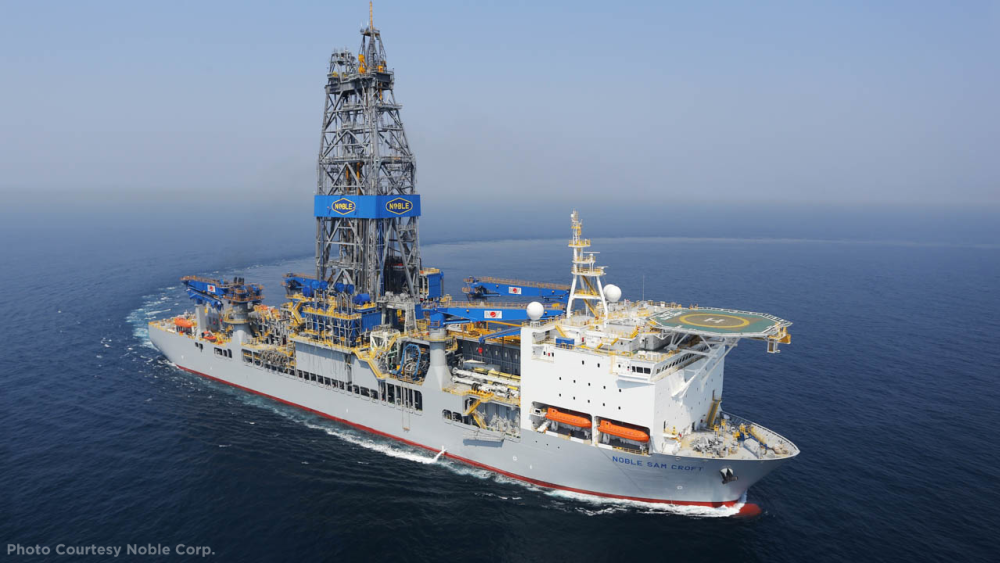
Despite not specifying the size of reserves in its latest discovery, Exxon Mobil said Pinktail will add to previous recoverable resource estimate of approximately 9 billion oil equivalent barrels. (Source: Shutterstock.com; image of Noble Sam Croft drillship by Hess Corp.)
Exxon Mobil Corp. struck oil at Pinktail in the Stabroek Block offshore Guyana, adding another discovery to the U.S. oil major’s exploration tally in the region.
The Pinktail well, located southeast of the Liza Phase 1 project and Yellowtail-1, marks the 20th significant discovery on the 6.6 million-acre Stabroek Block, which is operated by Exxon Mobil as part of a consortium that includes New York-based Hess Corp. and China’s CNOOC Ltd. Despite not specifying the size of reserves in its latest discovery, Exxon Mobil said Pinktail will add to previous recoverable resource estimate of approximately 9 billion oil equivalent barrels.
“These discoveries are part of an extensive well program in the Stabroek Block utilizing six drillships to test play extensions and new concepts, evaluate existing discoveries and complete development wells for the Liza Phase 2 and Payara projects,” commented Mike Cousins, senior vice president of exploration and new ventures at Exxon Mobil, in a company release.
Pinktail was drilled in 5,938 ft (1,810 m) of water by the Noble Sam Croft drillship and encountered 220 ft (67 m) of net pay in high quality hydrocarbon bearing sandstone reservoirs.
Also drilled by the Noble Sam Croft, the Turbot-2 well encountered 43 ft (13 m) of net pay in a newly identified, high quality hydrocarbon bearing sandstone reservoir separate from the pay encountered in the original Turbot-1 discovery well announced in October 2017. This follows the additional pay in deeper reservoirs encountered at the previously announced Whiptail discovery, according to the release.

Additionally, Exxon Mobil also announced on Sept. 9 that the Liza Unity FPSO vessel set sail from Singapore to Guyana in early September. The FPSO will be utilized for the Liza Phase 2 development and is expected to begin production in early 2022, with an output capacity of about 220,000 bbl/d of oil.
The consortium began producing crude at the Liza Phase 1 development in late 2019, which Hess CEO John Hess told an investor conference hosted by Barclays on Sept. 9 was producing at its nameplate capacity of 120,000 bbl/d.
He added the company expected the Stabroek Block to produce at least 1 million bbl/d through six FPSOs by 2027. Plus, the Payara project, the consortium’s third in the Stabroek Block, is expected to start up in 2024, he said.
Editor’s note: Reuters contributed to this article. Updated at 12:33 p.m. CST Sept. 9 to include a correction to an earlier Reuters report.
Recommended Reading
For Sale, Again: Oily Northern Midland’s HighPeak Energy
2024-03-08 - The E&P is looking to hitch a ride on heated, renewed Permian Basin M&A.
E&P Highlights: Feb. 26, 2024
2024-02-26 - Here’s a roundup of the latest E&P headlines, including interest in some projects changing hands and new contract awards.
Gibson, SOGDC to Develop Oil, Gas Facilities at Industrial Park in Malaysia
2024-02-14 - Sabah Oil & Gas Development Corp. says its collaboration with Gibson Shipbrokers will unlock energy availability for domestic and international markets.
E&P Highlights: Feb. 16, 2024
2024-02-19 - From the mobile offshore production unit arriving at the Nong Yao Field offshore Thailand to approval for the Castorone vessel to resume operations, below is a compilation of the latest headlines in the E&P space.
TotalEnergies Acquires Eagle Ford Interest, Ups Texas NatGas Production
2024-04-08 - TotalEnergies’ 20% interest in the Eagle Ford’s Dorado Field will increase its natural gas production in Texas by 50 MMcf/d in 2024.





